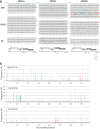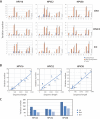Within-Host Variations of Human Papillomavirus Reveal APOBEC Signature Mutagenesis in the Viral Genome
- PMID: 29593040
- PMCID: PMC5974501
- DOI: 10.1128/JVI.00017-18
Within-Host Variations of Human Papillomavirus Reveal APOBEC Signature Mutagenesis in the Viral Genome
Abstract
Persistent infection with oncogenic human papillomaviruses (HPVs) causes cervical cancer, accompanied by the accumulation of somatic mutations into the host genome. There are concomitant genetic changes in the HPV genome during viral infection; however, their relevance to cervical carcinogenesis is poorly understood. Here, we explored within-host genetic diversity of HPV by performing deep-sequencing analyses of viral whole-genome sequences in clinical specimens. The whole genomes of HPV types 16, 52, and 58 were amplified by type-specific PCR from total cellular DNA of cervical exfoliated cells collected from patients with cervical intraepithelial neoplasia (CIN) and invasive cervical cancer (ICC) and were deep sequenced. After constructing a reference viral genome sequence for each specimen, nucleotide positions showing changes with >0.5% frequencies compared to the reference sequence were determined for individual samples. In total, 1,052 positions of nucleotide variations were detected in HPV genomes from 151 samples (CIN1, n = 56; CIN2/3, n = 68; ICC, n = 27), with various numbers per sample. Overall, C-to-T and C-to-A substitutions were the dominant changes observed across all histological grades. While C-to-T transitions were predominantly detected in CIN1, their prevalence was decreased in CIN2/3 and fell below that of C-to-A transversions in ICC. Analysis of the trinucleotide context encompassing substituted bases revealed that TpCpN, a preferred target sequence for cellular APOBEC cytosine deaminases, was a primary site for C-to-T substitutions in the HPV genome. These results strongly imply that the APOBEC proteins are drivers of HPV genome mutation, particularly in CIN1 lesions.IMPORTANCE HPVs exhibit surprisingly high levels of genetic diversity, including a large repertoire of minor genomic variants in each viral genotype. Here, by conducting deep-sequencing analyses, we show for the first time a comprehensive snapshot of the within-host genetic diversity of high-risk HPVs during cervical carcinogenesis. Quasispecies harboring minor nucleotide variations in viral whole-genome sequences were extensively observed across different grades of CIN and cervical cancer. Among the within-host variations, C-to-T transitions, a characteristic change mediated by cellular APOBEC cytosine deaminases, were predominantly detected throughout the whole viral genome, most strikingly in low-grade CIN lesions. The results strongly suggest that within-host variations of the HPV genome are primarily generated through the interaction with host cell DNA-editing enzymes and that such within-host variability is an evolutionary source of the genetic diversity of HPVs.
Keywords: APOBEC; genetic diversity; human papillomavirus; next-generation sequencing; quasispecies.
Copyright © 2018 American Society for Microbiology.
Figures






Similar articles
-
[Human Papillomavirus Carcinogenesis Mediated by APOBEC Mutagenesis].Yakugaku Zasshi. 2019;139(1):75-79. doi: 10.1248/yakushi.18-00164-3. Yakugaku Zasshi. 2019. PMID: 30606934 Review. Japanese.
-
Whole-Genome Analysis of Human Papillomavirus Type 16 Prevalent in Japanese Women with or without Cervical Lesions.Viruses. 2019 Apr 16;11(4):350. doi: 10.3390/v11040350. Viruses. 2019. PMID: 30995759 Free PMC article.
-
Genetic variation of human papillomavirus type 16 in individual clinical specimens revealed by deep sequencing.PLoS One. 2013 Nov 13;8(11):e80583. doi: 10.1371/journal.pone.0080583. eCollection 2013. PLoS One. 2013. PMID: 24236186 Free PMC article.
-
Genotype distribution of human papillomavirus (HPV) in histological sections of cervical intraepithelial neoplasia and invasive cervical carcinoma in Madrid, Spain.BMC Cancer. 2012 Nov 20;12:533. doi: 10.1186/1471-2407-12-533. BMC Cancer. 2012. PMID: 23167826 Free PMC article.
-
APOBEC-mediated genomic alterations link immunity and viral infection during human papillomavirus-driven cervical carcinogenesis.Biosci Trends. 2017 Sep 12;11(4):383-388. doi: 10.5582/bst.2017.01103. Epub 2017 Jul 17. Biosci Trends. 2017. PMID: 28717061 Review.
Cited by
-
The Natural History of Cervical Cancer and the Case for MicroRNAs: Is Human Papillomavirus Infection the Whole Story?Int J Mol Sci. 2024 Dec 3;25(23):12991. doi: 10.3390/ijms252312991. Int J Mol Sci. 2024. PMID: 39684702 Free PMC article. Review.
-
Synchronous anal canal carcinoma in a heterosexual couple.BMC Cancer. 2018 Sep 10;18(1):884. doi: 10.1186/s12885-018-4785-8. BMC Cancer. 2018. PMID: 30200930 Free PMC article.
-
Intra-Patient Genomic Variations of Human Papillomavirus Type 31 in Cervical Cancer and Precancer.Viruses. 2023 Oct 17;15(10):2104. doi: 10.3390/v15102104. Viruses. 2023. PMID: 37896881 Free PMC article.
-
Viral infection, APOBEC3 dysregulation, and cancer.Front Genet. 2024 Dec 23;15:1489324. doi: 10.3389/fgene.2024.1489324. eCollection 2024. Front Genet. 2024. PMID: 39764440 Free PMC article. Review.
-
Differences in integration frequencies and APOBEC3 profiles of five high-risk HPV types adheres to phylogeny.Tumour Virus Res. 2022 Dec;14:200247. doi: 10.1016/j.tvr.2022.200247. Epub 2022 Sep 11. Tumour Virus Res. 2022. PMID: 36100161 Free PMC article.
References
Publication types
MeSH terms
Substances
LinkOut - more resources
Full Text Sources
Other Literature Sources

